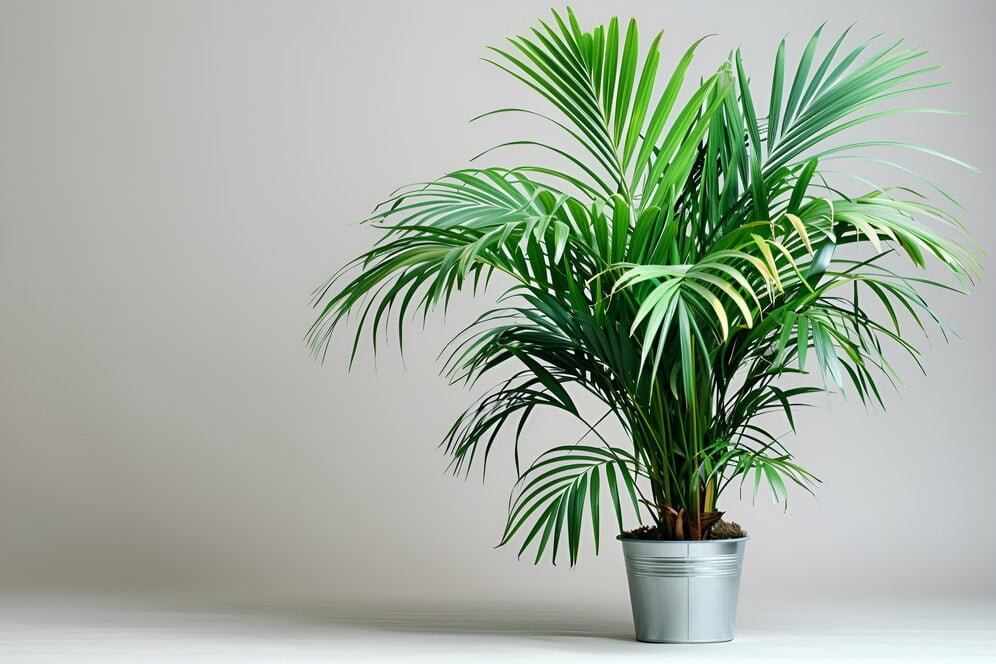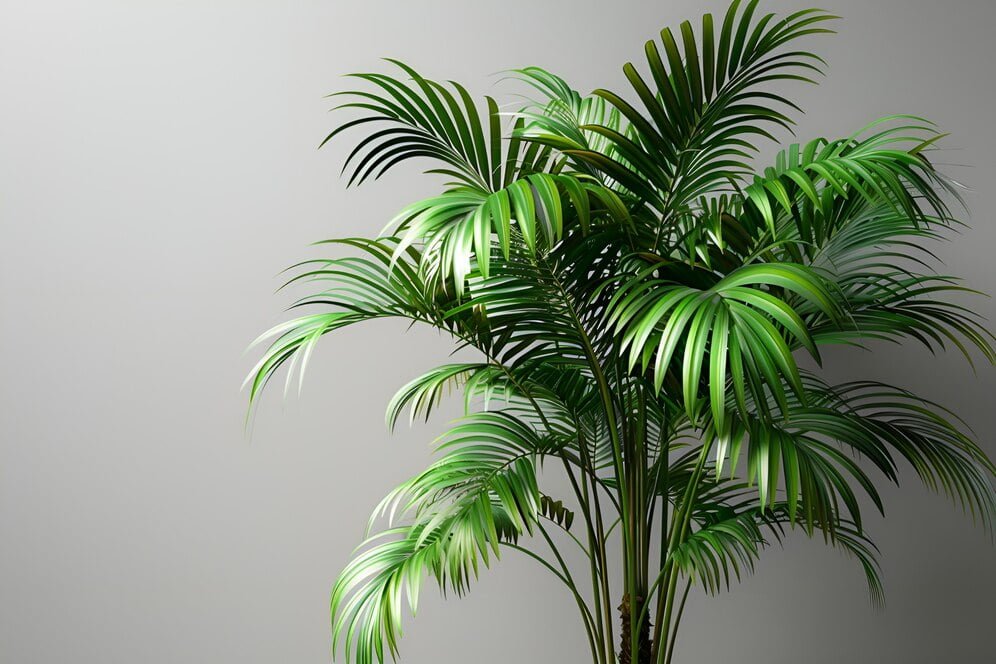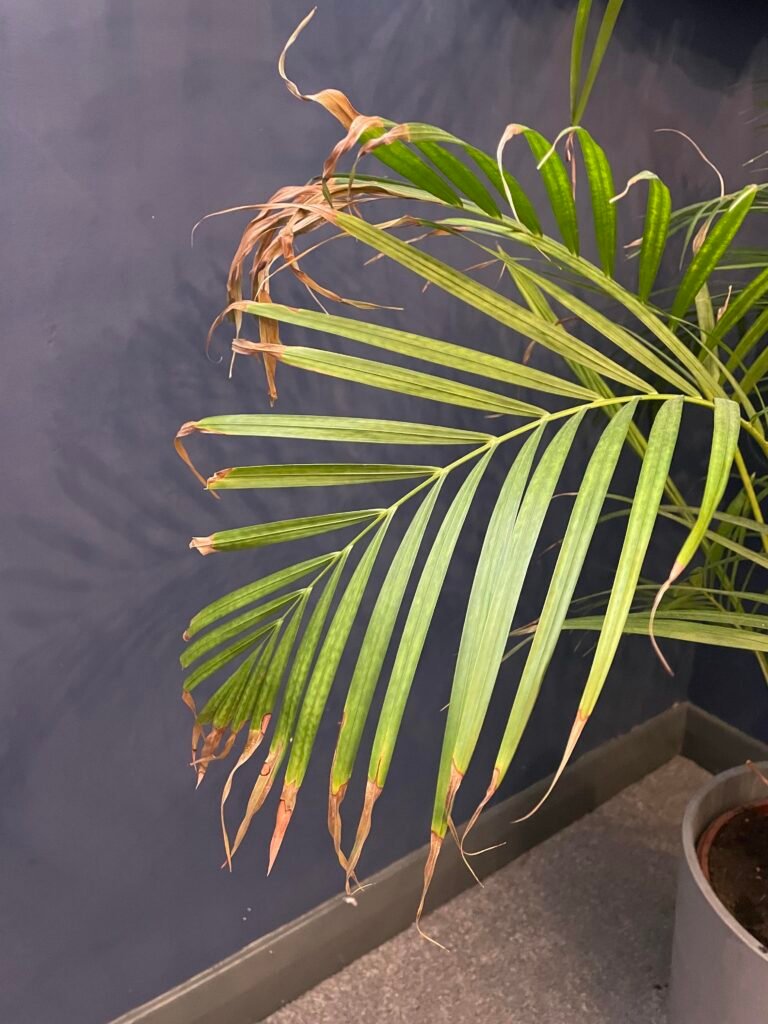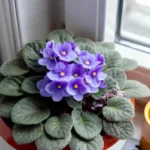Areca palm is a houseplant known worldwide for their easy maintenance and green, spreading leaves. Although the tree is native to Madagascar, it is now a well-known name to gardeners. When you hear the name Pam, you wouldn’t confuse Areca Palm with Pearl’s Pam. You have seen Areca palm somewhere because this tree is so popular that it is kept indoors in restaurants, houses, and hospitals.
You may also have seen experts on Instagram and TikTok detailing the benefits and care of keeping Areca palm at home. When I first brought Areca palm trees from the nursery and saw their spreading palm leaves, I unknowingly placed them in direct sunlight. The once-green leaves soon became dark brown and started to fall off within a few days.
After reading and doing research, I got the right idea about their care, and now my Areca Palms in my house are green and fresh all year round with no brown or black tips on the leaves. We will try to guide you in Areca Palm care in this article.
Areca Palm Overview
Areca Palm is a tropical forest plant in the Areaceae family. In the forest, they grow under the shade of large trees. Although Areca palm is native to Madagascar, it is widely distributed in India, Malaysia, and Indonesia. More than 51 varieties of Areca palm are known.
Although Areca palm is a common name, they have other names such as yellow palm, cane palm, butterfly palm. The Latin name of the tree is Chrysalidocarpus lutescens. Areca palm is used in various cultural rituals in India. Areca palms can grow indoors and outdoors. Areca palm trees are available in small, medium, and large sizes.
Scientific name: Dypsis lutescens
Planting time: Spring
USDA Zones: 10-11-Annual
Growth: 6-10 inches (3-10 feet)
Light: Bright indirect light (1.5-2 hours)
Areca Palm Care and Tips
Purchasing
When you buy an Areca palm tree from a nursery, check the leaves for any brown spots or tips and also look for mealybugs or mites on the backside of the leaves. Request healthy plants from a seller while making an online purchase.
No matter where you buy an Areca palm online or offline, get a healthy plant with fresh leaves. You should not bring home an Areca palm with a brown tip. When you bring home such a plant, it can become unhealthy even more quickly.
How much does areca Palm cost?
You can get an Areca palm tree from $10 to $60 depending on the size and pot of the plant at various online stores in America.

Placement
You can plant Areca palm indoors and outdoors in pots and directly into the ground (outdoors). Indoors, Areca palms should be placed near a window but out of direct sunlight. You can keep it anywhere in the house but avoid keeping it in the dark. You can also keep Areca Palm in the kitchen and bathroom.
Pot
You should plant the Areca palm in a perforated pot. Put the nursery pot inside a decorative cover pot. By no means should you use an Areca palm in a pot without holes, as this can put your plant at risk.
Soil
Areca palm plants need well-drained soil. I make my Areca palm medium with potting soil, worm compost, sand, and a small amount of perlite. I don’t use coco coir because it keeps the soil moist. Areca palm needs high soil moisture and good drainage.
Avoid adding stones, coco coir, or too much fertilizer when preparing the soil. If you don’t use well-drained soil, your plant may develop rot problems. You can add herbicides when preparing the soil.
Water
Water your Areca palm tree with utmost care. Areca palm trees may require frequent watering during the dry season but need very little water during the winter season. When the top two or three inches of soil is no longer wet, it’s time for you to water. It is better to water when 30-50% of the soil is dry.
Water the plant little by little until water appears to be escaping the pot’s drainage holes, at that point stop watering. You can use the finger method or a moisture meter to test the soil. I rotate both tap water and filtered water for the Areca palm.
Do not use either tap or filtered water exclusively for long periods, as this can cause brown tips on Areca palm leaves. You can water your indoor Areca palm by harvesting rainwater during the rainy season. If possible, take them outside during the rain and let them soak, but ensure the drainage hole is not blocked. Watering can be done 1 or 2 times a week in the growing season, and once every 30-40 days during the winter season.
Light
1-2 hours of bright light indoors is sufficient for Areca palm plants. Keep them out of direct sunlight. If they receive light for more than 1-2 hours, their leaves will start to turn brown. Outdoors, plant them in a place where they receive filtered light.
Temperature
Ensure 50°-80°F (15°-25°C) and humidity of 40-60% for Areca palm indoors. They should be kept under temperature control during the winter season. Store them in a place where it does not fall below 50°F (10°C). If the temperature is too low, the tips of their leaves may die, and the leaves will look brown. Avoid placing them on a dry windowsill or in a drafty location.
You can use a digital temperature meter to control and measure the temperature at home.

Fertilizer
Areca palm plants do not produce much fruit or seeds indoors. Usually, they do not have buds or flowers. It’s not necessary to invest a lot of money in them. You can add organic fertilizers directly to their soil.
During their growing season, from spring to summer, I add worm compost and manure directly to the topsoil by stirring it with a chopstick. I also mix these fertilizers with water and give them to the roots of the plants. Avoid giving them nitrogen, potassium, phosphorus, or NPK fertilizers.
Indoors, they grow very slowly, and if you add these fertilizers, the plant’s growth and photosynthesis may be disturbed. I always give them organic fertilizers within every 2 months during the growing season. It keeps my Areca palms very healthy and green.
Repotting
Since Areca palm trees grow slowly, you don’t need to repot them often. You may need to repot them once every 2-3 years. You can do repotting during the growing season. When repotting, transplant the Areca palm into a 2- or 3-inch larger pot. After repotting the Areca palm, water it and try to keep it away from light.
Once adjusted to the new medium and pot, bring the plant back to it’s original location.
Pruning Your Areca Palm
You can’t make seedlings from Areca palm branches or leaves like you can with Pothos-type plants. You don’t need to prune them branch by branch, but you can cut them off when the leaves are all brown. If you see a brown or black tip on the leaf, cut that part with a pruner.
We bring Areca Palms home for their palm-like leaves, so the bushier their leaves are, the more beautiful they become.
Ventilation
You can place Areca palm near a window or door as they need air. It is best if placed near the Southeast-facing window.
If you find the Areca soil a bit hard, dry, and dark in color, take a chopstick and make a hole in the medium soil with the chopstick to ensure air circulation in the medium.
Wipe Leaves
I like the spreading, long palm fronds of my Areca palm. But their leaves get dusty, which looks ugly. You will clear their leaves. I put a small amount of water in a bowl and clean the leaves with a cotton cloth, you can also use paper towels. I’ve seen using microfiber gloves to clean leaves, the key here is to protect the leaves
It makes the leaves look darker and greener after some time. Mix a few drops of neem oil with water; the leaves will look darker and shinier.
Take a Bathe
Once a week, you can bathe the Areca palm in your bathroom to clean the leaves of your plant, and any insects on the leaves will be washed away. Do not water the plant for 1 or 2 days before you take it to bathe.
Spraying
If you don’t water the plants regularly, you can wet the leaves by misting them with a spray. As a result, the leaves of the plant will be clean, and the process of photosynthesis will not be disturbed.
You can spray the Areca palms in your house every 2/3 days. Spraying will moisten the plant’s body and leaves, which the Areca palm tree likes. After spraying, you can put it near a fan to dry.
Areca Palm Propagation
You can grow Areca Palms from seeds, but transplanting from seed is time-consuming. You can grow Areca palm trees by dividing the branches.
Areca Palms are very branching plants that you can carefully separate them from their roots. However, you cannot plant them from twigs or leaves.
Dormancy Period
Areca palm trees go dormant during the winter like other trees. Growth stops. Avoid pruning them at this time. Try to keep your room temperature controlled and dry. Avoid fertilizing the plant at this time.
Fertilizer should only be applied to Areca palm plants in the growing season. Water every 4-6 weeks to understand soil moisture and be sure to check with your fingers.
Outdoor Areca Palm
You can keep Areca palm trees indoors as well as outdoors. Areca palm trees enhance the beauty of your home. Areca palm trees can make great additions to hedging and landscaping. However, like indoors, you should keep the Areca palm out of direct sunlight outdoors.
Their leaves can burn in the heat of the sun. Outdoor Areca palm trees can reach up to 30 feet. Areca palm trees grow best outdoors when you position large plants around them. You can plant the Areca palm trees by maintaining a little distance without planting side by side; in this, the trees will be lined up on one side, and the air circulation will be ensured.
If you want to set the Areca palm in a pot in front of the door, place it in partial shade. Outdoors, you may need to water more frequently during dry seasons, but in other seasons, they won’t need as much water because their roots are able to draw water from deep in the soil. Outdoors, they produce seeds that are rare to see indoors. You can bring your plant indoors (if in a pot) in winter or when the humidity drops below freezing.

Picture credit: Reddit
Root Rot and Recovery
Areca Palms can irritate you a little; even if you overwater them, their leaves will tip, and even if you water less, their leaves will tip. They can confuse you. Overwatering can cause their roots to rot. When you are overwatering, the soil is wet, and the roots of the plants are sitting in the soil, so they are telling you that you are watering them too much and the tips of the leaves are turning brown.
If the tips of the leaves begin to turn brown, stop watering the plant. If you check the top of the plant and find that the top has turned black, quickly clean the soil and transplant the plant into a new tub and medium. One of the problems with Areca palm is root rot.
You can use water mixed with hydrogen peroxide to fix root rot problems.
Eliminate and Repel Insects
Areca palm is not attacked by many insects, but some common pests are. Aphids, mealybugs, spider mites, and ants are visible on the underside of their leaves. It’s easy to get rid of them.
Neem Oil: Mix one teaspoon of neem oil with one liter of water and spray it on your Areca palm tree.
Pesticides: There are many types of insecticides, so choose one that is safe for your Areca palm. Check pesticide levels before purchasing. Spray the plant with insecticide and water (according to the label).
Dish Soap: Take dish soap you have at home and dilute it with water. Mix 3/4 drops of dish soap (liquid) with 1 liter of water and spray directly on the insects.
This way, you can easily repel harmful insects from your Areca palm tree at home. You should regularly spray water mixed with neem oil on your Areca palm tree. You can do it 1 or 2 times a month; this will keep harmful insects away from your plant, and leaves will look more glossy.
Areca Palm Benefits
Areca palm trees add warmth to your home. Increase the amount of oxygen in the air and absorb carbon dioxide. They remove chemical compounds in your house, such as benzene, formaldehyde, and carbon monoxide, which are harmful to the human body. Areca palm plays a great role in decorating your house with green foliage and aesthetics. Areca palm is one of the plants that clean the air in NASA research.
Areca palm is easy to maintain and requires very little care. Decorate your home’s exterior walls and help enhance the beauty of your lawn. Having Areca palm trees in your home will improve your mental health and reduce your stress by maintaining them. Areca palm trees are a perfect hedge plot for you if you live in a dusty area of the USA and you are in zone 10-11.
Areca palm leaves can trap dust which will reduce the amount of dust and dander in your house, thereby eliminating allergy problems.
Areca Palm Friendliness
The good news for houseplant parents is that the Areca palm in your home is a safe and nontoxic plant for your furry four-legged friend. Safe for your little one at home.
Areca Palm Uses
Areca palm is well-known as a houseplant, but traditionally, its nuts are mixed with drinks in various Asian countries, exchanged in religious ceremonies, especially Hindu weddings. In many Asian countries traditionally, Areca cultivation is used as a livelihood.
Areca palm trees can be a great addition to your home. As they confuse you, you may be confused by the tips of their leaves. But you should keep in mind that their leaves have brown tips because of excess water, less water, excess light, if you maintain them they can be a great plant for you. A plant that is nontoxic for your home’s cats, dogs and small children.










